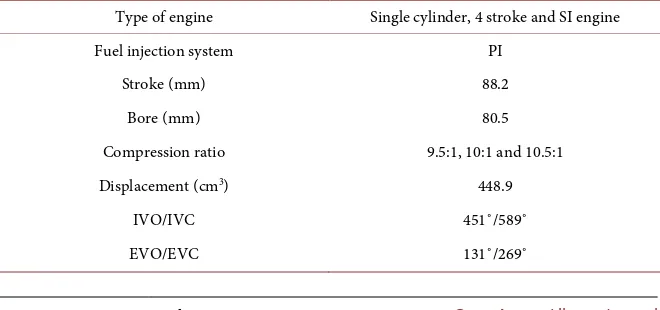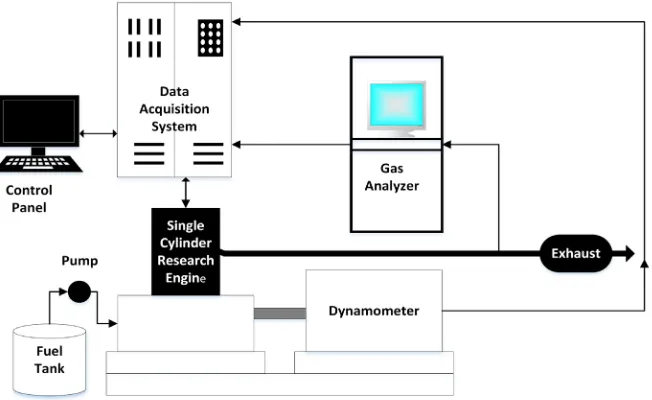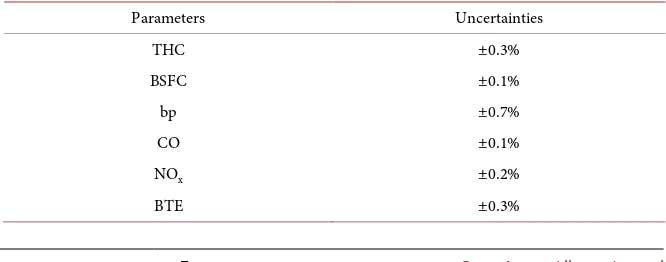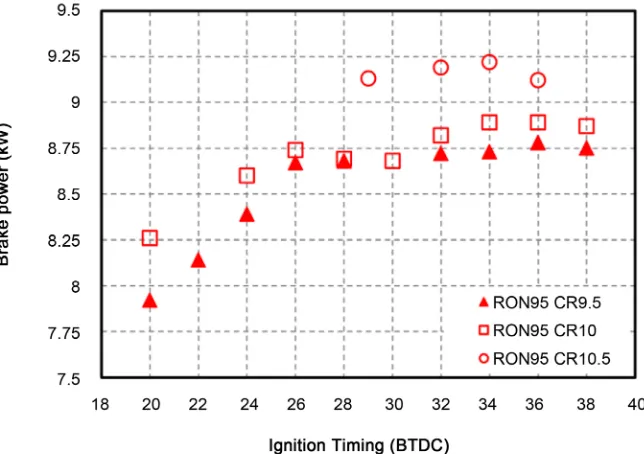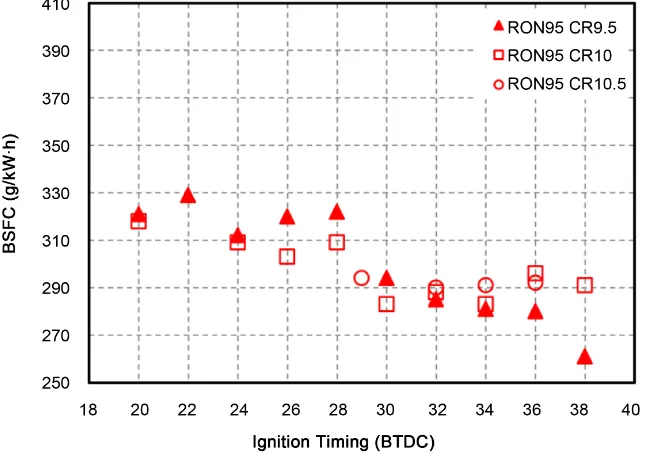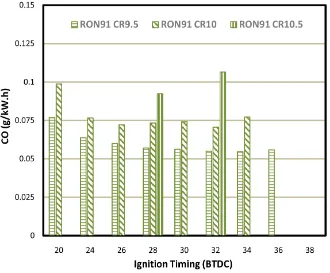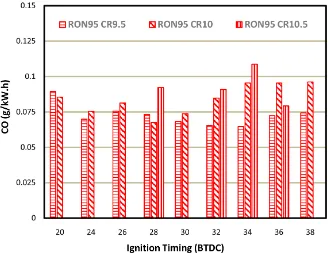ISSN Online: 2333-9721 ISSN Print: 2333-9705
DOI: 10.4236/oalib.1104184 Dec. 28, 2017 1 Open Access Library Journal
Combustion and Emission Analysis of SI Engine
Fuelled by Saudi Arabian Gasoline RON91 and
RON95 with Variable Compression Ratios and
Spark Timing
Saud A. Binjuwair
*, Abdullah M. Alkhedhair, Ahmed A. Alharbi, Ibrahem A. Alshunifi
Water and Energy Research Institute, King Abdulaziz City of Science and Technology, Riyadh, KSA
Abstract
The performance, emissions and combustion characteristics of a spark igni-tion engine at varying compression ratio and spark timing using two grades of gasoline in Saudi Arabian market, RON91 and RON95 have been presented on this paper. The tests were conducted using a single cylinder, four-stroke spark ignition research engine that operates with different RON fuel. The experiments were conducted at a wide-open throttle with an engine speed of 2500 rpm at stoichiometric conditions for three different compression ratios (9.5:1, 10:1, 10.5:1). At each compression ratio, the spark timing was varied till knocking is detected. The performance characteristics such as brake power, specific fuel consumption, thermal efficiency, in-cylinder pressure, rate of heat release, and exhaust emissions were analyzed. The data shows that the increasing of compression ratio and spark timing increased the brake power and decreased the brake fuel consumption for both type of fuels. Increasing compression ratio was more advantageous for RON95 due to the auto-ignition resistance event. The NOx emission was insignificantly
de-creasing as compression ratio increases with lower NOx emission from
RON91. Compression ratio had considerable effect on CO emission for both fuels.
Subject Areas
Mechanical Engineering
Keywords
Compression Ratio, Spark Timing, RON, Exhaust Emissions How to cite this paper: Binjuwair, S.A.,
Alkhedhair, A.M., Alharbi, A.A. and Alshunifi, I.A. (2017) Combustion and Emission Analysis of SI Engine Fuelled by Saudi Arabian Gasoline RON91 and RON95 with Variable Compression Ratios and Spark Timing. Open Access Library Journal, 4: e4184.
https://doi.org/10.4236/oalib.1104184
Received: November 22, 2017 Accepted: December 25, 2017 Published: December 28, 2017
Copyright © 2017 by authors and Open Access Library Inc.
This work is licensed under the Creative Commons Attribution International License (CC BY 4.0).
http://creativecommons.org/licenses/by/4.0/
DOI: 10.4236/oalib.1104184 2 Open Access Library Journal
1. Introduction
The growing demand on internal combustion (IC) engines, in particular spark ignition (SI) engines, coupled with tightening emission regulations have driven the development of more powerful, efficient and cleaner SI engines [1]. In the last decades, SI engines received considerable effort to enhance the combustion process, reduce fuel consumption, improve fuel formulations and decrease un-desirable pollutant emissions. There are several ways to improve SI engines effi-ciency and emissions including engine design, formulation of fuels, compression ratio, fuel injection and mixing, ignition timing, treatment of reactant and ex-hausts, etc. [2].
The compression ratio of the engine that is determined according to fuel for-mulation and engine geometry represents one of the most important parameters that affect the performance of SI engines. Compression ratio is defined as the ra-tio of the maximum cylinder volume to the minimum compressed volume [3]. The impact of compression ratio on engine thermal efficiency and exhaust emis-sions is significant. According the Carnot principle, engine theoretical thermal efficiency is enhanced by increasing the compression ratio [4]. However, in SI engines, increasing the compression ratio is restricted by the fuel-knocking limit. Engine knocking phenomena occurs due to the undesirable auto ignition of the air-fuel mixture, which leads to an irregular combustion process. This engine knock adversely influences the engine performance including low thermal effi-ciency and tendency to mechanical failure. Fuel octane number is another im-portant parameter in SI gasoline engines concerning the fuel anti-knock quality [5]. Higher fuel octane number allows higher compression ratio and offers better knock resistance [3]. In addition, spark timing is a potential parameter regarding engine knocking, particularly at variable engine load operation.
Several experimental investigations on local Saudi Arabian RON grades were carried out previously by the authors to study the effect of important combus-tion parameters on engine performance and emissions formacombus-tion. These studies include determining the effect of spark timing [6] and fuel injection system [7] on engine performance using Saudi Arabian market gasoline: RON91 and RON95. Results from these studies showed that spark timing and fuel injection system influence combustion and emissions significantly. It was observed that fuel octane number has a major effect on engine efficiency and exhaust emis-sions. In these researches, the increasing of spark timing increased the brake power and decreased BSFC for both type of fuels with RON95 showing higher brake power and lower BSFC than RON91. In addition, it has been found that RON91 emitted lesser NOx emissions and higher CO emissions than RON95.
Regarding the fuel injection system, mixed results were obtained to different en-gine speed and fuel system [7].
com-DOI: 10.4236/oalib.1104184 3 Open Access Library Journal pressed natural gas, etc., have been conducted by several investigations. Several researches in the literature studied the effect of compression ratio on SI engines performance fuelled with gasoline. Attrad et al. [8] conducted experiments to investigate the SI engine performance and exhaust emissions run at different compression ratios. The tests were performed on a two-cylinder SI engine fu-elled with RON98 under compression ratios ranging from 9:1 to 13:1. They re-ported that with the increase of the compression ratio, higher brake power out-put and better fuel economy were obtained. They stated that the increase of compression ratio resulted in higher in-cylinder pressure due to the rapid initial burn rate. Costa and José [9] investigated the influence of compression ratio on a SI engine performance experimentally. The investigation compared 10:1, 11:1 and 12:1 compression ratios of a four-cylinder engine with gasoline and hydrous ethanol as fuel. It was found that increasing compression ratio resulted in a sig-nificant increase of the in-cylinder pressure and brake power, and a decrease in the fuel consumption, hence improved thermal efficiency. Sayin et al. [10] expe-rimented on a SI engine operated with gasoline and iso-butanol/gasoline blend fuel run at compression ratios of 9:1, 10:1 and 11:1. The results show that the in-crease of compression ratio led to better thermal efficiency and minimum fuel consumption. In addition, lower CO and THC emissions were observed at high-er compression ratios.
Numerical and experimental investigations were carried out by Smith et al. [11] to study the effect of compression ratio from 8 to 13.4 on SI engines per-formance. The observations indicated that increasing compression ratio revealed an improvement in the brake thermal efficiency by 5.1%. Aina et al. [12] con-ducted an experimental and a theoretical study to evaluate the effect of compres-sion ratio on SI engine efficiency. In this study, as comprescompres-sion increased, it was found that a decrease in specific fuel consumption by 7.75%, an improvement in the brake thermal efficiency by 8.49%, and an increase in brake power by 1.34% were obtained. A number of studies have been also conducted regarding the ef-fect of compression ratio on the performance of Homogeneous Charge Com-pression Ignition (HCCI) engines. Christensen et al. [13] tested several com-pression ratios over the range of 10:1 to 28:1 on HCCI with a constant AFR of 3.0 using a dual port injection system. The results showed that reduction of NOx
emissions was observed with increased compression ratio. However, lower combustion efficiency was obtained with an increasing compression ratio.
DOI: 10.4236/oalib.1104184 4 Open Access Library Journal by several researchers. Abdel-Rahman et al. [14] reported that using ethanol blended gasoline fuel improved thermal efficiency with the increase in compres-sion ratio. They observed that there is an optimum value of comprescompres-sion ratio for maximum engine thermal efficiency based on the fuel blend. Zhao et al. [15] observed the performance of a SI engine operated with hydrogen-enriched nat-ural gas at varied compression ratio. The results indicated that higher compres-sion ratio improved the combustion conditions.
In view of the literature review, the effect of compression ratio related to fuel type need to be studied clearly. Therefore, in this study, two available gasoline grades from Saudi Arabian market (RON91 and RON95) were investigated with respect to compression ratio to analyze and evaluate the effects of compression ratio on SI engine performance and exhaust emissions. Experimental investiga-tion using the two local RON grade gasoline fuels were conducted under three different compression ratios at various spark timing from 20˚CA BTDC till knocking was detected at WOT and engine speed of 2500 rpm. The perfor-mance, exhaust emission and combustion characteristics were studied and com-pared. The experimental findings will benefit in the development of engine per-formance regarding fuel formulation.
2. Experimental Investigation
2.1. Experimental Setup
A Lotus Single Cylinder Research Engine (SCRE) located at the King Abdulaziz City for Science and Technology (Combustion Lab) was utilized to conduct this research. The engine is a four-stroke, spark-ignition (SI) gasoline engine with water-cooled and naturally aspirated. Table 1 demonstrates Engine specifica-tions and run settings. In order to study the influence of the compression ratio (CR) on the engine combustion and performance, three compression ratios (9.5:1, 10:1, 10.5:1) were employed by using three modified piston crown that were prepared. Figure 1 shows the flow chart of the experiments and Figure 2 shows piston crowns for three compression ratios.
[image:4.595.208.538.589.744.2]Figure 3 shows the test cell comprises of SCRE and the 30 kW Eddy-current type dynamometer. Figure 4 shows a schematic diagram of the setup. The fuel
Table 1. Specification of SCRE.
Type of engine Single cylinder, 4 stroke and SI engine
Fuel injection system PI
Stroke (mm) 88.2
Bore (mm) 80.5
Compression ratio 9.5:1, 10:1 and 10.5:1
Displacement (cm3) 448.9
IVO/IVC 451˚/589˚
DOI: 10.4236/oalib.1104184 5 Open Access Library Journal
Figure 1. Flow chart of the experiments.
[image:5.595.220.527.513.704.2]DOI: 10.4236/oalib.1104184 6 Open Access Library Journal
Figure 3. Single cylinder engine test cell: 1—eddy current
dy-namometer; 2—single cylinder; 3—valve cam box; 4—Balance gear box; 5—Exhaust pipe; 6—Intake filter.
Figure 4. A schematic diagram of the experimental setup.
[image:6.595.213.539.372.572.2]emis-DOI: 10.4236/oalib.1104184 7 Open Access Library Journal sions of CO, THC and NOx. A fuel injector made by Bosch actuated by engine
control unit was used for the port fuel injection. To control the spark timing electronically, a Lotus V8 controller was used.
2.2. Uncertainty Analysis
Uncertainty calculations were done as the method described by Shyam [16]. The recording of 100 cycles of in-cylinder pressure at a resolution of crank angle 0.5 ˚CA was averaged to compute combustion-related parameters. Table 2 shows the measurements accuracy and uncertainty of apparatuses and Table 3 shows calculated parameters utilized in this experimental investigation. The genera-lized approach for uncertainties calculations is used to determine the uncertain-ties in all calculated parameters is as follows:
For a generalized result R= f p p
(
1, 2,,pj)
, the total uncertainty in R is given by Equations (1) and (2):(
) (
2)
2(
)
21 1 2 2 , ,
r j j
U =
θ
∗u +θ
∗u + +θ
∗u (1)j i
R p
θ = ∂
∂ (2)
where uj is the uncertainty in the quantity pj and θj is the sensitivity coef-ficient of f with respect to pj. Total experiment uncertainty for both meas-ured and calculated parameters are ±1.06% and ±1.7% respectively.
3. Results and Discussion
[image:7.595.208.540.489.581.2]A series of experiments were carried out for three different compression ratios of (9.5:1, 10:1, 10.5:1) at a constant speed of 2500 rpm and wide throttle open at
Table 2. Uncertainty of accuracy of measurements.
Parameters Range Accuracy Uncertainties
Speed 0 - 12,000 RPM ±1 ±0.0001%
Torque 0 - 95 N·m ±0.25 ±0.26%
Fuel consumption 0.03 - 20 l/h ±0.1 ±0.5%
Temperature 0˚C - 1000˚C ±1 ±0.1%
Pressure sensor 0 - 250 bar ±0.5 ±0.2%
Table 3. Uncertainty of calculated results.
Parameters Uncertainties
THC ±0.3%
BSFC ±0.1%
bp ±0.7%
CO ±0.1%
NOx ±0.2%
[image:7.595.205.538.613.744.2]DOI: 10.4236/oalib.1104184 8 Open Access Library Journal stoichiometric mixture using a single cylinder research engine. The engine was operated at various spark timing and varied from 20˚CA BTDC until knock is detected in incremental steps of 2˚CA. As can be noticed in investigation results, in some cases, the engine could not be operated at retarded and/or advanced ST; this is due to that fuel with higher octane number enhanced knock tolerance and allowed wider range of operation at high compression ratio and advanced spark timing that allow more favorable variables. As a result, fewer measurements are obtained for the case of high compression ratio and low octane number. Fur-thermore, in order to distinct the effect of compression ratio on the engine per-formance and exhaust emissions, the optimal spark timing of 32˚CA BTDC was selected. The fuel delivery system is port injection with injection pressure of 2.3 bar and injection starting (SOI) at 360˚ crank angle BTDC. Thermal efficiency, bp, BSFC, in-cylinder pressure, heat release, and exhaust emissions were ob-tained and analyzed. In the case of changing testing fuel, adequate time of opera-tion was allowed before taking measurements to make sure that the fuel utilized beforehand is removed from the fuel system.
3.1. Brake Power
[image:8.595.211.534.474.707.2]The engine brake power is defined as the actual engine output power measured at the output shaft. Engine brake power for RON91 and RON95 fuels at three compression ratios (9.5:1, 10:1, 10.5:1) with different spark timing are shown in Figure 5 and Figure 6, respectively. It can be seen that the brake power increas-es when spark timing increasincreas-es for both fuels. While as comprincreas-ession ratio in-creases, the outcomes are different related to different RONs. With RON95, the brake power increases as compression ratio increases. These findings are in agreement with Costa et al. [9] and Aina et al. [12]. At the peak power for both
DOI: 10.4236/oalib.1104184 9 Open Access Library Journal
Figure 6. Engine brake power with RON95.
fuels, the RON91 showed better performance at CR9.5 by 1.14% compared to CR10. Unlike RON95 in which the higher compression ratio case CR10 showed improved performance by 1.2%. The advantage of RON95 is obvious in terms of brake power with CR10 and CR10.5. This can be explained by the fact that au-to-ignition resistance is higher while having comparable heating value to RON91. The peak brake power achieved by RON91 was 9.25 kW at 32˚CA BTDC ST and CR10.5. While with RON95 peak power was 9.2 kW at 34˚CA BTDC ST and CR10.5. For both RONs, maximum power were achieved with the highest compression ratio operated CR10.5.
3.2. Thermal Efficiency
DOI: 10.4236/oalib.1104184 10 Open Access Library Journal
Figure 7. Engine thermal efficiency with RON91.
Figure 8. Engine thermal efficiency with RON95.
timing, CR9.5 showed superiority to CR10 and even CR10.5. There were not significant changes in the thermal efficiency of different compression ratios at 32˚CA BTDC ST.
3.3. Brake Specific Fuel Consumption
DOI: 10.4236/oalib.1104184 11 Open Access Library Journal
Figure 9. Engine brake specific fuel consumption with RON91.
Figure 10. Engine brake specific fuel consumption with RON95.
DOI: 10.4236/oalib.1104184 12 Open Access Library Journal
al. [12]. Further reduction of fuel consumption was achieved when using higher RON fuel. The RON95 acquired 10% to 13% lower fuel consumption relative to RON91. However, in the case of RON95, even though at more retarded igni-tions, CR9.5 showed worst fuel consumption, this trend reversed as spark ad-vance progress. The minimum consumption of 260 g/kWh was found with CR9.5 at 38˚CA BTDCST. This value is 8% and 11% less than the minimum BSFC with CR10 and CR10.5, respectively.
3.4. Emissions
Three toxic engine emission species that need to be controlled were measured in this investigation including; carbon monoxide, CO, oxides of nitrogen, NOx and
[image:12.595.211.541.435.708.2]total hydrocarbon, THC. Figure 11 and Figure 12 show CO emissions ofRON91 and RON95 fuels for the three compression ratios and different spark timing. In the case of RON91 fuel, CO emissions increased as compression ratio increases. However, it was observed that CO emissions decreased as spark timing advanced with CR9.5 and CR10 up to 28˚CA BTDCST. The behaviour is different with RON95 fuel in which CO emissions first decreased with spark advancing up to 30˚CA - 34˚CA BTDC and then increased with further advancement of ignition. At 32˚CA BTDC ST, CO emissions increased as compression ratio increased for both fuels and the advantage of RON95 over RON91 in reducing CO emissions is obvious with 12% less CO produced at higher compression ratios. Generally, for greater spark timing, combustion time is extended thus allowing better com-pletion resulting in lower CO emissions. Additionally, with lower compression
DOI: 10.4236/oalib.1104184 13 Open Access Library Journal ratio, peak cylinder temperature is reduced which can lead to less probability to dissociation of CO2 to CO.
Figure 13 and Figure 14 show NOx emissions of RON91 and RON95 fuels
[image:13.595.210.538.428.707.2]respectively, for the three compression ratios and different spark timing. An
Figure 12. Carbon monoxide emissions with RON95.
DOI: 10.4236/oalib.1104184 14 Open Access Library Journal
Figure 14. NOx emissions with RON95.
overall observation showed that there is little variation of NOx emissions with
respect to compression ratio. For both fuels, when the compression ratio in-creased from CR9.5 to CR10, a slight decrease of NOx emissions was observed.
However, NOx emissions increased with ignition advancement. RON91 offered
better NOx level with 6% - 15% less than those of RON95 over the whole range.
As NOx emissions are proportionate to combustion temperature, it was clear
that advancing ignition caused peak cylinder temperature to rise and therefore more NOx emissions.
DOI: 10.4236/oalib.1104184 15 Open Access Library Journal
[image:15.595.211.536.336.571.2]Figure 15. Total hydrocarbon emissions with RON91.
Figure 16. Total hydrocarbon emissions with RON95.
when the optimum spark timings are reached. It can also be seen that the aver-age and the minimum THC with RON91 are lower than that of RON95 by around 15%.
3.5. Combustion Analysis
DOI: 10.4236/oalib.1104184 16 Open Access Library Journal
Figure 17. In-cylinder pressure of fuels (RON91 and RON95) at 32˚ crank angle BTDC ST for varied compression ratios.
for both fuels, the peak pressure increases as the compression ratio rises. Fur-thermore, RON95 fuel showed higher in-cylinder pressure than RON91 at CR10, but when the compression ratio increased to CR10.5; both fuels displayed almost the same in-cylinder pressure values. Table 4 shows the peak pressure locations at different compression ratios for the two fuels. It can be seen that RON91 make lower and delayed peak pressure happening, in particular at CR10.
ROHR of RON91 and RON95 fuels is calculated from the pressure data rec-orded by the evaluation software from Lotus-Engine based on the single Weibe heat release function. Figure 18 shows ROHR plots and Table 5 demonstrates the peak of ROHR values and events, which are the parameter of interest. Gen-erally, higher peak ROHR at earlier occurrence of RON95 was observed with in-creasing compression ratio compared to RON91. With CR10.5, two peaks in the ROHR plot are noticeable for two of heat release phases representing the pre-mixed and diffusion combustion phases respectively. RON95 displayed a more noticeable diffusion combustion phase than RON91. This is attributed to the RON95 has lower calorific value per unit volume of fuel.
DOI: 10.4236/oalib.1104184 17 Open Access Library Journal
Table 4. Cylinder pressure peak values and event timings over all compression ratios at
32˚CA BTDC ST.
Compression ratios
RON 91 RON 95
Event timing
(˚CA ATDC) Peak pressure (bar) (˚CA ATDC) Event timing Peak pressure (bar)
9.5 15.3 50.36 14.3 50.245
10 17.5 50.585 16.1 52.123
[image:17.595.207.539.222.616.2]10.5 17.4 52.679 17.4 52.647
Table 5. ROHR peak values and even timing over all compression ratios at 32˚CA.
Compression ratios
RON 91 RON 95
Event timing
(˚CA ATDC) (kJ/mROHR peak 3 ˚CA) (˚CA ATDC) Event timing
Peak of ROHR (kJ/m3 ˚CA)
9.5 7 116.73 7 117.44
10 10 123.02 6 125.89
10.5 4 124.48 2 126.5
Figure 18. ROHR of RON91 and RON95 at 32˚CA BTDCST for different CRs.
DOI: 10.4236/oalib.1104184 18 Open Access Library Journal engine is considered stable when COVIMEP is less than 10%. The COVIMEP for 100
successive engine cycles was calculated as in Equation (3) at each operating con-dition [19]. Table 6 demonstrates that COVIMEP decreased with advancement in
spark timing and rise in compression ratio from CR9.5 to CR10 for both fuels. However, COVIMEP increased when increasing compression ratio from CR10 to
CR10.5. It can be seen that the COVIMEP of the RON95 fuel is lower than that of
RON91 fuel. Therefore, the engine seems to be running more stable with RON95 fuel. IMEP IMEP COV 100 IMEP σ
[image:18.595.208.540.243.445.2]= × (3)
Table 6. Variation of the COVIMEP at compression ratios and spark timing for both fuels.
Spark timing (˚CA BTDC)
COVIMEP (%)
RON91 RON95
CR9.5 CR10 CR10.5 CR9.5 CR10 CR10.5
20 2.760 3.610 2.670 2.520
24 2.460 2.360 1.880 1.620
26 1.730 1.780 1.700 1.530
28 1.290 1.600 3.890 1.390 1.120 1.550
30 1.050 1.170 0.947 0.901
32 0.971 0.926 0.880 0.744 0.702 0.896
34 1.120 0.737 0.713 0.720 0.895
36 0.957 0.872 0.741 1.080
38 1.020 0.883
4. Conclusions
In this paper, an experimental investigation was performed to address the effect of fuel formulation at variable compression ratio over different spark timing on the performance and exhaust emissions of a spark ignition engine. Two available gasoline grades from Saudi Arabian market (RON91 and RON95) were investi-gated. Experimental study was operated at stoichiometric condition using a sin-gle cylinder engine under three compression ratios of 9.5:1, 10:1, 10.5:1 and va-rying spark timings from 20˚CA BTDC with increment of 2˚CA till knocking is detected at an engine speed of 2500 rpm and wide throttle open.
DOI: 10.4236/oalib.1104184 19 Open Access Library Journal terms of exhaust emissions, the compression ratio effect was insignificant re-garding NOx and THC emissions. Nevertheless, the RON91 produced lower NOx
and HC rates than RON95. However, unlike NOx and THC, the compression
ra-tio effect on CO emission was significant. Increasing the compression rara-tio would increase the CO emissions due to the rise in the peak cylinder tempera-ture. RON95 gave lower CO emissions than RON91 in particular at higher com-pression ratios with 12% less CO emission produced at comcom-pression ratio of 10.5. Combustion performance shows higher peak ROHR at earlier occurrence of the RON95 fuel with increasing compression ratio compared to RON91 fuel.
Based on all of the results, increasing the fuel octane number improved the engine power and BSFC with the increased compression ratio. Increased com-pression ratio augmented mixture burning for both fuels besides increased oc-tane number allowed more resistance to knocking. Therefore, these conse-quences improved the engine performance and reduced fuel consumption while there was a trade-off among exhaust emissions of NOx, CO and THC.
Acknowledgements
This work was financially supported by the King Abdulaziz City of Science and Technology, Water and Energy Research Institute (Project No. 1193-36).
References
[1] Qi, D.H., Liu, S.Q., Zhang, C.H., et al. (2005) Properties, Performance, and Emis-sions of Methanol-Gasoline Blends in a Spark Ignition Engine. Proceedings of the Institution of Mechanical Engineers, Part D: Journal of Automobile Engineering, 219, 405-412. https://doi.org/10.1243/095440705X6659
[2] Cao, Y. (2012) An Internal Combustion Engine Platform for Increased Thermal Ef-ficiency, Constant-Volume Combustion, Variable Compression Ratio, and Cold Start. International Journal of Energy Research, 36, 682-690.
https://doi.org/10.1002/er.1823
[3] Heywood, J. (1988) Internal Combustion Engines Fundamentals. McGraw-Hill, New York.
[4] Kwon, E., Kyeongsoo, S., Minsoo, K., et al. (2017) Performance of Small Spark Igni-tion Engine Fueled with Biogas at Different Compression Ratio and Various Carbon Dioxide Dilution. Fuel, 196, 217-224.https://doi.org/10.1016/j.fuel.2017.01.105 [5] Gautam, K. and Richard, S. (2017) Fuel Requirements of Spark Ignition Engines.
Proceedings of the Institution of Mechanical Engineers, Part D: Journal of Automo-bile Engineering, I-14.
[6] Saud, B. and Abdullah, A. (2016) The Effects of Varying Spark Timing on the Per-formance and Emission Characteristics of a Gasoline Engine: A Study on Saudi Arabian RON91 and RON95. Fuel, 180, 558-564.
https://doi.org/10.1016/j.fuel.2016.04.071
[7] Saud, B., Mohamad, A., Taib, I., et al. (2015) The Effects of Research Octane Num-ber and Fuel Systems on the Performance and Emissions of a Spark Ignition Engine: A Study on Saudi Arabian RON91 and RON95 with Port Injection and Direct Injec-tion Systems. Fuel, 158, 351-360.https://doi.org/10.1016/j.fuel.2015.05.041
DOI: 10.4236/oalib.1104184 20 Open Access Library Journal
Performance, Efficiency, Emissions and Combustion in a Carbureted and PFI Small Engine. SAE Technical Paper 2007-01-3623.
[9] Costa, C. and Sodré, R. (2011) Compression Ratio Effects on an Ethanol/Gasoline Fuelled Engine Performance. Applied Thermal Engineering, 31, 278-283.
ttps://doi.org/10.1016/j.applthermaleng.2010.09.007
[10] Sayina, C. and Balki, M. (2015) Effect of Compression Ratio on the Emission, Per-formance and Combustion Characteristics of a Gasoline Engine Fueled with Iso-Butanol/Gasoline Blends. Energy, 82, 550-555.
https://doi.org/10.1016/j.energy.2015.01.064
[11] Smith, P., Heywood, J. and Cheng, W. (2014) Effects of Compression Ratio on Spark-Ignited Engine Efficiency. SAE Paper, 2014-01-2599.
https://doi.org/10.4271/2014-01-2599
[12] Aina, T., Folayan, O. and Pam, Y. (2012) Influence of Compression Ratio on the Performance Characteristics of a Spark. Applied Science Research, 3, 1915-1922. [13] Christensen, M., Hultqvist, A. and Johansson, B. (1999) Demonstrating the Multi
Fuel Capability of a Homogeneous Charge Compression Ignition Engine with Va-riable Compression Ratio. SAE Paper, 1999-01-3679.
[14] Abdel-Rahman, A. and Osman, M. (1997) Experimental Investigation on Varying the Compression Ratio of Si Engine Working under Different Ethanol–Gasoline Fuel Blends. International Journal of Energy Research, 21, 31-40.
https://doi.org/10.1002/(SICI)1099-114X(199701)21:1<31::AID-ER235>3.0.CO;2-5 [15] Zhao, J.B., Ma, F.H., Xiong, X.W., et al. (2013) Effects of Compression Ratio on the
Combustion and Emission of a Hydrogen Enriched Natural. Energy, 59, 658-665. https://doi.org/10.1016/j.energy.2013.07.033
[16] Shyam, M. (2006) Performance Measurement and Scaling in Small Internal Com-bustion Engines. Master’s Thesis, University of Maryland, College Park, Maryland. [17] Patterson, D. (1966) Cylinder Pressure Variations, a Fundamental Combustion
Problem. SAE Paper 660129.https://doi.org/10.4271/660129
[18] Grzegorz, L., Tomasz, K., Jacek, C., et al. (2009) Combustion Process in a Spark Ig-nition Engine: Analysis of Cyclic Peak Pressure and Peak Pressure Angle Oscilla-tions. Meccanica, 44, 1-11.https://doi.org/10.1007/s11012-008-9148-0
DOI: 10.4236/oalib.1104184 21 Open Access Library Journal
Abbreviation
ATDC= After top dead center AFR= Air-fuel ratio
BSFC= Brake specific fuel consumption BTDC= Before top dead center
bp= Brake power
CR= Compression ratio
CO= Carbon monoxide
HCCI= Homogeneous charge compression ignition IC= Internal combustion
NOx= Nitrogen oxides
PI= Port injection
RON= Research octane number ROHR= Rate of heat release
ST= Spark timing
SOI= Start of injection
SCRE= Single cylinder research engine THC= Total hydrocarbon
